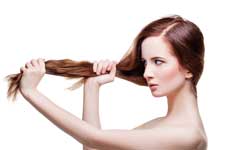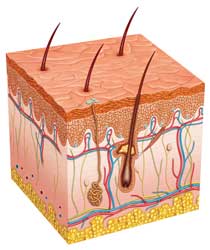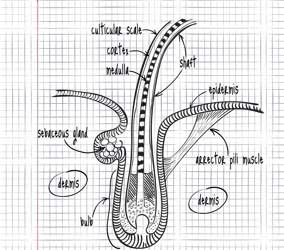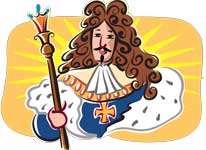Shopping Cart
There are no more items in your cart
The hair: An adornment for the human being
-
Categories :
Our hair beauty tips
The social and individual importance given today to physical appearance undoubtedly explains the growing attention given to hair and hairdressing.
What is a hair?
Why take care of your hair?
Hair: an adornment?
- Hair, a reflection of health and beauty, a symbol of power and seduction, is often at the center of aesthetic concerns for women as much as for men. Without forgetting that the hair also has a functional role by protecting the skull and indirectly the brain, from climatic hazards (sun, cold or bad weather) and trauma.
Hair story
- Hair and elaborate hairstyles have always been associated with the idea of refinement, social representation and civilization. The oldest representations of hair are the Egyptian headdresses. Men and women were shaved and wore wigs of natural hair, wool and vegetable fibers.
- In the classical period, Greeks and Romans had short hair while the Barbarians (Gauls, Germans etc.) remained hairy. In 1674, Louis XIV formalized the function of "barber wig maker". Symbol of social ease and good taste. Wearing a wig then became an essential fashion. There were a variety of them, but the most coveted was the royal wig: a mane with large stepped curls, particularly imposing, with a weight of 1.5 kg.
- The size of these wigs also caused all kinds of ailments such as stiff necks, migraines, ringing in the ears, pruritus and alopecia from traction.
Quite a symbol
- In Greco-Roman mythology, the hair is a symbol of seduction in women (Aphrodite, Venus, Ariadne, etc.), of strength and power in men: Samson drew his prodigious strength from his opulent hair, never cut . Delilah discovered his secret and made him vulnerable by having his hair cut. Thus, stripped of his hair and his strength, he could be reduced to slavery.
- The symbolism of strength and power associated with hair is also expressed, in time of war, to establish its domination or victory: scalps taken by the Indians from their vanquished enemies, tonsure inflicted by the Romans on vanquished peoples or shaving of the prisoners in concentration camps.
- Shaving your hair has been, and still is, a sign of surrender and submission. In the Buddhist religion, the bonzes are shorn to manifest their asceticism. Among the Christians, the capitulars of 630 forced the religious to shave and to renounce the means of pleasing. Moreover, even today, Christian monks impose the tonsure on themselves as a sign of renunciation.
- Nowadays, the physical appearance, in which dress style and hairstyle participate, has a particular importance to sign the belonging to an ethnic group (braids of African-Americans for example), social or socio-cultural (long hair of rock musicians , unconventional punks hairstyles, shaved hair of rappers, etc ...).
How is the hair made?
- It is not because its diameter is microscopic that the hair does not have a complex structure. From the stem to the bulb, let's discover its anatomy.
- The visible part of the hair or body hair consists of a keratin rod. This characteristic substance of the epidermis is formed of fibers and fibrils made up of chains of amino acids twisted into a helix which ensure the cohesion, rigidity and solidity of the hair.
Hair resistance

- Mechanical resistance tests have revealed that the breaking load of a hair is of the order of 50 grams. Thus, a hair of 100,000 hairs could support a weight of 5,000 kg !. Ethnicity is also involved in the strength of hair. The weakest being hair of Caucasian origin, followed by African hair and the strongest being hair of Asian origin.
- Elasticity is the hair's most important property. Up to a certain tensile threshold, it returns to its original length and shape. The elongation capacity of a dry hair is 30% of its length. But it can reach 100% after humidification.
The composition of the hair
- As opposed to the skin keratin which is supple. That of the hair is a very hard fiber. The hair is anchored by its root in a depression in the skin through the layers of the epidermis, the dermis and the hypodermis.

The hair has two elements:
- The rod which is the visible part, the color of which varies depending on the individual. It is made up of three very distinct consecutive layers:
- The marrow which is the central layer made up of more or less disjointed cells without nucleus.
- The cortex which is a layer of keratinocyte cells more or less pigmented and elongated in the direction of the hair.
- And the cuticle which is a superficial layer of the hair shaft and made up of several layers of keratinocytes flattened and piled on top of each other like pine bark or roof tiles.
- The root or bulb is implanted obliquely in the scalp. At its lower part. She has a small depression where the blood vessels and nerves that make up the papilla are lodged. The root is contained in a sac, the whole of which is called the hair follicle. There is a sebaceous gland at the base of the hair or hair, which secretes sebum, and a muscle, the arrector muscle, which causes goose bumps. This is to keep the skin warm when it is cold.

What are the treatments that will beautify my hair?
To benefit from the tailor-made adaptation of your Geomer products free of charge according to your seasonal needs, complete the Diagnosis My Tailor-Made Shampoo :
Less and less hair ...
- At birth, each person has around 5 million hairs. This number decreases with age. There are thus 100,000 to 150,000 hairs in adults. This represents a density of approximately 300 hairs per cm². It should also be noted that browns have less hair than blondes who, however, have hair of small diameters.

- For many years, Laboratoire Géomer has become one of the specialists in hair regrowth thanks to a technique known for thousands of years: cutaneous lymphatic drainage and cell regeneration. These two phases of care are found in all Géomer hair care products which deal with man hair fall / women and of regrowth.
Do you want to know your personalized treatment? Make the hair diagnosis:
Alain Ledroit CEO Laboratoire GéomerReiki Master UsuiThis article has interested you ?
Do not hesitate to share !
A question ?
CONTACT US BY CLICKING HERE >>
Tel France: +33185089191 or Tel Belgium: +3223181065




